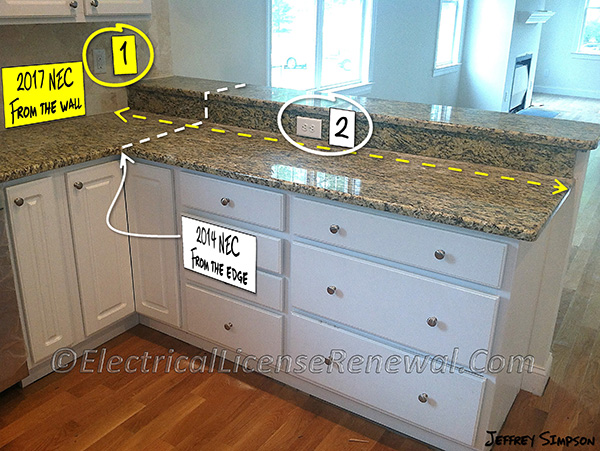210.52(C)(3) Peninsular Countertop Spaces.

Code Change Summary: Additional code language clarifies how to measure a kitchen peninsula when determining receptacle placement.
For many code cycles, a kitchen peninsula has been measured from the “connecting edge” which is where the peninsula countertop makes connection to the kitchen countertop. In the 2017 NEC® a peninsula is now measured from the connected perpendicular wall.
This means that receptacle number 1 in the image, installed to serve the countertop wall space can also serve as the receptacle required for the peninsula because receptacle 1 is located within the envelope of the peninsula. According to the revised 2017 code language, receptacle 2 in the image is not necessary.
In the 2014 NEC®, both receptacle 1 and 2 in the image were code required since the peninsula was measured from the connecting countertop edge and did not go clear to the wall. Now that the 2017 NEC® requires the peninsula to be measured from the adjacent wall, the receptacle required for the peninsula can be satisfied by receptacle 1 in the image which also serves the adjacent counter.
Below is a preview of Article 210. See the actual NEC® text at NFPA.ORG for the complete code section. Once there, click on their link to free access to the 2017 NEC® edition of NFPA 70.
2014 Code Language:
210.52(C)(3) Peninsular Countertop Spaces. At least one receptacle outlet shall be installed at each peninsular countertop space with a long dimension of 600 mm (24 in.) or greater and a short dimension of 300 mm (12 in.) or greater. A peninsular countertop is measured from the connecting edge.
2017 Code Language:
210.52(C)(3) Peninsular Countertop Spaces. At least one receptacle outlet shall be installed at each peninsular countertop long dimension space with a long dimension of 600 mm (24 in.) or greater and a short dimension of 300 mm (12 in.) or greater. A peninsular countertop is measured from the connected perpendicular wall.